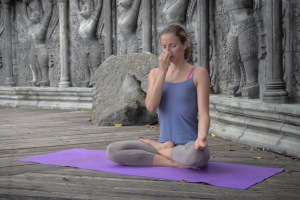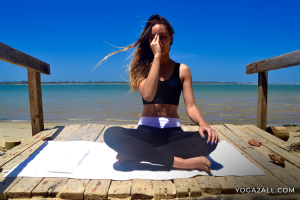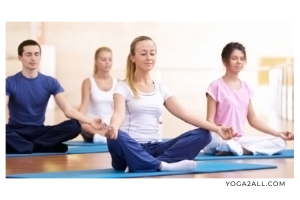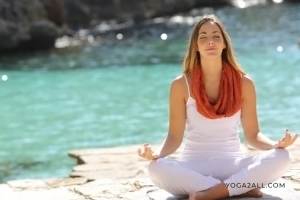There are three types of Pranayam. Inferior (Adhama) Pranayam, Middle (Madhyama) Pranayam and Superior (Uttama) Pranayam. The inferior pranayama consists of twelve mantras, the middle pranayama consists of twenty four mantras and the superior pranayama consists of thirty two mantras.
Pranayama also called Pranayam is an ancient practice concerned with breathing control or called breathing exercise. Studies revealed that pranayama can relieve symptoms of asthma. Pranayama is also beneficial for stress relief, such as anxiety and depression. But many of the experts consider that there are total six types of pranayama or breathing practice.
Bhastrika pranayam or Bellow breathing exercise:
This is one of the most popular pranayama or breathing exercise considered by yoga gurus.
Breathe in deeply through your nostrils. At first feel diaphragm move down, allowing the lungs to expand and forcing the abdomen out, then just feel your chest expand with your collar bones rising last. Now breathe out quickly through your nostrils. Feel the collar bones dropping, chest deflating, and abdomen shrinking as the lungs collapse. This is one of the process for exhaling which should be much faster than the process of inhaling. When you are correctly done this process, your chest will expand when you breathe in and deflate when you breathe out. Now continue doing for at least 5- 6 minutes. Do practice your breathing speed. At the very first time you need to start very slowly to avoid hyperventilating, but over time, by practice a lot you can try to turn this into a rapid breathing exercise.
Kapalbhati Pranayama or Shining Forehead Breathing exercise:
Inhale through your nostrils normally until and unless your lungs are full. Now keep your inhalation slow but do not force. At the first time, feel the diaphragm move down, allowing the lungs to expand and forcing the abdomen out, then just feel your chest expand with your collar bones rising last. Now this is the time to exhale through both of the nostrils forcefully. This places emphasis of the breath on the exhale rather than the natural inhale. Now you need to assist your exhalation by pulling your stomach muscles to expel air. Exhaling need to take much less time that it took to inhale. Now repeat your breaths for 15- 16 minutes at least and take rest after every 5 minutes.
Anulom Vilom Pranayama or Alternate Nostril Breathing exercise:
At first close your eyes and focus your attention on your breathing. Now close your right nostril with your right thumb and simply press the thumb against your nostril to block it. Inhale slowly through the left nostril and fill your lungs with air. At the first time, you need to feel the diaphragm move down, allowing the lungs to expand and forcing the abdomen out, feel your chest expand with your collar bones rising last. Now remove your thumb from your right nostril. Now you need to keep your right hand by your nose and your lungs full of air. You should use your ring and middle finger to close your left nostril. Most of the people find it very comfortable to continue using the same hand to block either nostril, but you can use both of the hands depending on which nostril you are blocking. Now exhale slowly and completely with the right nostril and feel that your collar bones dropping, chest deflating, and abdomen shrinking as the lungs collapse. When you have finished exhaling, keep your left nostril closed. Inhale through the right nostril. Fill your lungs. Now close your right nostril and open the left. You need to breathe out slowly through the left nostril, because this process is one round of Anulom Vilom Pranayama or Alternate Nostril Breathing exercise. Same as you need to continue for 15 -16 minutes and take at least after every 5 minutes.
Bahya Pranayama or External Breathing exercise:
Kumbakha is the retention of breath. In this pranayama, the breath is retained outside for a longer duration than inhalation and exhalation. The ratio of inhalation, exhalation and retention is 3: 6:12
At first feel the diaphragm move down, allowing the lungs to expand and forcing the abdomen out and feel your chest expand with your collar bones rising last. Exhale forcefully and use your stomach and diaphragm to push air from your body. Now touch chin to your chest and suck in your stomach completely though comfortably. You need to do this because the main reason is to leave a hallow below your ribcage, making it look like the front muscle wall of your abdomen is pressed against the back. Hold this position with your breath as long as you can do it. Now lift your chin and breathe in slowly and allow your lungs completely fill with air. You can repeat this process 4-5 times.
Bhramair Pranayama or Bee breathing exercise:
At first close your eyes and do focus on your breathing. Place your thumbs in your ears and your index fingers above your eyebrows, and your remaining along the sides of your nose. Keep each of your pinky finger near a nostril. Breathe in deep through your nose and feel the diaphragm move down, allowing the lungs to expand and forcing the abdomen, feel your chest expand with your collar bones rising last. Now you need to use your pinkies to partially close each nostril and keep your lungs filled. Now breathe out through the nose while humming. You can repeat it 2 – 3 times.
Udgeeth Pranayama or Chanting Breathing:
At first breathe in deeply through your nose and feel the diaphragm move doen, allowing the lungs to expand and forcing the abdomen out and feel your chest expand with your collar bones rising last. Now exhale slowly while saying OOOOOOM. (Sound of ‘O’ needs to be long – like – OOOOOOOO and sound of ‘M’ needs to be short – like – MM.
Repeat this 3 – 4 times.
Happy Practicing!







Nice article. The Kapalbahti, which is active exhaling and passive inhaling exercise, tones up and cleanses the respiratory system and cures many diseases.
Hey Andrew, very thanks for your comments…….looking forward for your further reply.